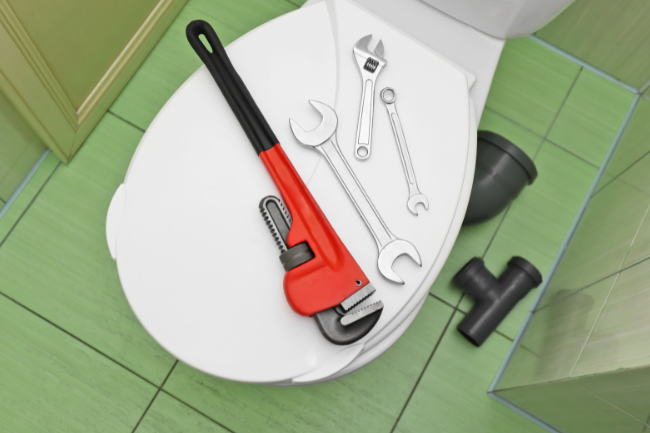4 Reasons Why You Need a Pipe Inspection
Posted by William Heinselman on
Your plumbing system may be behind a wall, but it ages just like any other appliance system would, even if you can’t see it. Clogs and leaks can weaken the integrity of your pipes, and more so if your piping is not routinely cleaned or maintained.

Drain cleaners are another factor since the chemicals wear out your pipes’ walling. All of these issues can lead to significant damage and increase the risk of plumbing problems for homeowners and commercial buildings.
If it’s been a few years since you’ve had your pipes checked, and you’re concerned about their current state and age, here are a few reasons why having a professional pipe inspection is necessary.
What’s the Purpose of a Pipe Inspection?
We use plumbing systems in some sort of capacity every day. Whether we go to the bathroom, wash dishes, or take a shower, our piping has constant objects and debris being flushed down them. Because we can’t see them, we often forget that our pipes can take a heavy amount of damage. Some of the reasons include:
- Debris Buildup: Hair, soap scum, and food scraps are just a handful of things that can get stuck in the pipes and lead to obstructions. Buildup from these items can create consistent clogging problems and may lead to unpleasant odors.
- Tree Roots: Roots are drawn to sewer lines because they contain water, nutrients, and oxygen, which trees need to grow. As nice as they are, trees and their roots can cause a ton of unseen damage to pipes, like cracks and contamination of the water. Since plumbing systems and tree roots are both underground, the tree roots have the potential to puncture or push through the piping and cause sewer backup.
- Earthquakes: If you live along a fault line that is prone to frequent earthquakes, then you have a whole other reason to protect your pipes. The shifting ground can cause just enough damage underneath that your pipes could be crushed or bent.
The real issue comes from our inability to see these problems when they’re present. Since pipes are underground, we often just assume everything is working as it should be. Only a professional Sacramento plumbing service can spot hidden issues since they have the proper equipment to check a pipe’s integrity.
4 Reasons to Have Your Pipes Inspected

You don’t want to have an underground problem costing you hundreds, or even thousands, of dollars in repairs and maintenance. Here are the most common reasons you should have a professional plumbing inspection.
1. Damages
When pipes get damaged, it can cause all sorts of problems like leaks, water contamination, and even structural breakdowns. But with regular pipe inspections, you can spot things like cracks, corrosion, and blockages that might not be obvious at first glance. This early detection allows us to take action with preventive maintenance and repairs, which in turn lowers the chances of dealing with expensive and inconvenient pipe failures down the road.
2. Outdated Plumbing Materials
A pipe inspection becomes particularly vital when dealing with outdated plumbing materials. Aging pipes made from materials like galvanized steel or lead are more susceptible to corrosion, leaks, and degradation over time. These materials can pose serious health and safety risks, as they may contaminate the water supply with harmful substances.
An inspection and replacement service will become absolutely necessary for you if you know your plumbing system is made up of one of these three outdated types of pipes:
- Lead: Lead is one of the oldest metals used for piping and was mainly used for sewer and water main lines. However, lead is highly toxic and regular contact can result in joint and gastrointestinal pain, irritability, memory loss, and even physical and mental development issues in children. The use of lead was restricted in 1920, but it wasn’t banned in full until Congress passed the Safe Drinking Water Act in 1986.
- Galvanized: Galvanized pipes are made from iron and then coated with a layer of zinc. While the piping itself can last almost 60 years, the zinc erodes over time and can cause the pipes to become clogged with rust.
- Polybutylene: Once seen as an alternative to traditional copper piping, this pipe material was considered the “pipe of the future” due to its easy installation and low cost. The manufacturer was forced to pay out millions, however, when a lawsuit alleged the pipes of being defective. The material experienced a chemical reaction with oxidants in public water that led to the plastic flaking, becoming brittle, and then cracking. This type of material no longer meets U.S. building codes and should be replaced in any home or commercial building before failure.
- Orangeburg: Made from wood and sealed with coal tar, Orangeburg piping saw widespread use during WWII for housing developments due to the shortage of cast iron materials needed for the war effort. Because of the brittle materials and poor structural strength, these pipes experienced failure after about ten years, though they were expected to last for 50 years. Though obsolete, this type of piping can still be found in older home models.
Regular pipe inspections can help identify signs of wear and tear in these outdated systems, allowing homeowners and property managers to address potential issues before any serious damage occurs.
3. Property Renovations
Pipe inspections are vital for property renovations for a number of reasons, including:
- Provide a comprehensive assessment of the existing plumbing system, helping renovation teams identify potential problems such as leaks, blockages, or outdated materials that may not be immediately visible.
- Help in planning the renovation process more efficiently, allowing for adjustments in design and layout if necessary.
- Ensure that any new plumbing installations integrate seamlessly with the existing system, enhancing the overall functionality and efficiency of the property.
- Improve the long-term durability and reliability of their plumbing, reducing the need for costly repairs in the future.
In essence, pipe inspections are a cornerstone of successful property renovations, contributing to both immediate project success and long-term property value.
4. Buying a New House
Pipe inspections are a critical step when buying a new house, as they provide valuable insights into the condition of the property's plumbing system. A thorough assessment can uncover hidden issues such as leaks, blockages, or deteriorating pipes that might not be apparent during a routine home inspection.
Identifying these problems upfront allows prospective buyers to make informed decisions about the property, negotiate repairs or pricing adjustments if needed, and avoid unexpected expenses down the line.
Schedule a Pipe Inspection With Trusted Sacramento Plumbers
At Express Sewer, we offer a wide range of plumbing solutions to fix any piping issue found in your home or commercial plumbing system. Our experienced professionals use only the best precision tools and equipment to safely and easily remove your old or outdated piping for an affordable rate. Contact one of our Sacramento plumbing professionals to receive your free quote today!
Topics: Plumbing in Sacramento, Trenchless Technology, Sewers



![How to Prevent Flooding [6 Tips to Protect Your Property]](https://www.expresssewer.com/hubfs/prevent_flood.png?width=550)



